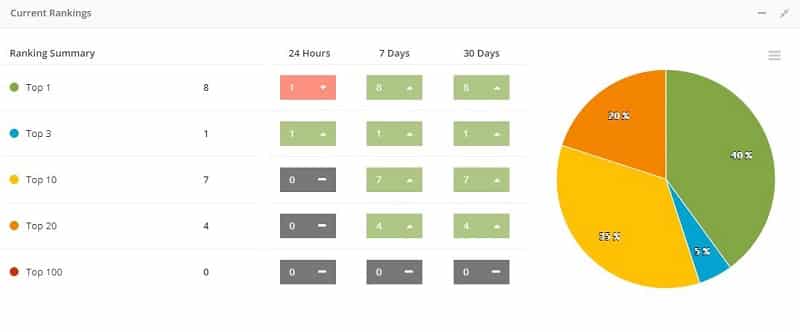Last Updated on June 18, 2020 by admin
At Netvantage, we use a rank tracker religiously. While keyword rankings are not the only data point important for search engine optimization, it is one of the items that clients tend to focus on most. We find it important to make sure we are always using the best tools, so we explore other options from time to time.
Our team recently tried three different rank tracking tools. Here are my thoughts on each.
RankTracker
RankTracker offers a 10-day trial for a single URL and up to 10 keywords. Since we have both national clients and local clients, I tested our national client first before swapping out the domain for a local client.
Set Up
The set up for RankTracker was a breeze. The tool breaksdown the addition process into three categories.
- Domain
- Simply copy and paste your selected URL.
- Keywords
- Add your selected keywords. RankTracker also lists suggested keywords for the domain.
- Part of the keywords section is the tracking settings where you select your location and the search engine you would like to track the keywords.
- Competitors
- Again, copy and paste the domain of a competitor you would like to track.
While I didn’t utilize the suggested keywords during the trail, I can see how it would be beneficial when looking for more keywords for a new client.
Accuracy
RankTracker was very accurate for the keywords we tracked during the trial. In fact, its rankings for our national client were more accurate than our current rank tracking tool. The rankings were spot on when I swapped out the domain for our smaller local client too.
Dashboard
I *think* I like RankTracker’s dashboard, but it is hard to say since the trial only allows for one URL. A search function allows you to quickly pull up the domain you are looking for data on. I think the domain page is what I would utilize more. The image below is from the domain page and I’m assuming it would list the domains in alphabetical order with data for each. I hope it is still a nice clean look with additional domains.

At Netvantage, we often reference the average keyword ranking for each domain. This helps us ensure there are no major drop-offs, which is one of the main reasons I like the way the domain tab is set up.
Reporting
If you need a quick export of that day’s rankings, RankTracker made it easy with an export button right above the domain’s keywords that spits out a CSV file for you.
The reports section did seem more complicated than it needed to be. I set up “daily” reports, but never found a way to see them or download them. It’s very possible that I needed to spend more time monkeying around with the tool, which sometimes isn’t always an option with a short trial period.
Overall Grade: A-
I think we will look into RankTracker when our current plan is up. Spending more time figuring out the reporting aspect will be important, but the domain layout is what is really appealing here.
Pro Rank Tracker
Pro Rank Tracker is a 7-day trial that allows for 20 keywords and 2 URLs. To get the best feel for the rank tracker, we tired a small local client and a larger national client.
Set Up
Pro Rank Tracker has a few different options for adding a URL to the platform. When adding our clients in, I used the ‘Advanced Add’ option, so it is the only one I can speak to. Overall, it was relatively easy. I completed the following steps:
- Select the Tracking Type
- Tracking Type Options: Organic, Organic Local, Mobile, Local Finder, Search Elements, YouTube Video, and Amazon Listing
- Utilized the Manual Add option
- They have a file upload option, but with only adding 10 keywords for each client, I did not feel the need to test this option.
- Add the URL and Search Terms
- Selected Google for the Search Engine and the proper city for Local Tracking
- The last step is to organize into Groups or with Tags
- I did not utilize this feature since we were only doing a trial.
Accuracy
When comparing Pro Rank’s keyword rankings to our current rank tracker, the rankings were the same or better for the local client. The national client had more differences in ranks compared to our current rank tracker, but overall, it was more accurate.
Dashboard
ProRank Tracker’s dashboard view has data that I have not seen in other tracking tools. It shows ranking changes over 24 hours, 7 days, and 30 days for all URLs and keywords. It also categories the keywords in the top 1, top 3, top 10, etc. as shown below.

The dashboard also shows up to 10 keywords for the biggest jumps in rankings and the biggest drops in rankings in the last 24 hours.

The way the dashboard is set up works for two URLs and 20 keywords. When you add in more URLs and get to nearly 5,000 keywords, it would be possible to miss a lot of ranking changes. From talking to a customer support agent, there are a lot of email alerts that can be set up for individual URLs to help you stay updated on changes in rankings though. With nearly 60 domains, this would require a lot of leg work to get set up properly.
Reporting
I found the reporting process to be one of the best parts of the tool. You can easily export a CSV file with the following columns right next to each other:
- Current Rank
- Yesterday Rank
- Week Ago Rank
- Month Ago Rank
The data being right next to each other helps determine where a keyword may have increased or decreased.
Overall Grade: B
I mentioned previously that we are big fans of the average position for each domain and Pro Rank Tracker doesn’t have that, which is my biggest problem with the tool. I also think that the dashboard feature would be overcrowded quickly when we added additional domains.
RankTrackr
Note, this is different than RankTracker above. It’s confusing, I know.
RankTrackr is a 10-day trial. The trial allows for 20 URLs and up to 50 keywords. For consistency in testing, I used the same small local client and the larger national client as the previous tools.
Set Up
Pro Rank Tracker has a few different options for adding a URL to the platform. When adding our clients in, I used the ‘Advanced Add’ option, so it is the only one I can speak to. Overall, it was relatively easy. I completed the following steps:
- Select the Search Engine
- If you want to track the same keywords on different search engines, you have to complete the setup process multiple times. Search engine options include Google, YouTube, Google Places, Bing, and Yahoo.
- Copy and paste the URL or domain you want to track
- Add the keywords
- Below the keywords are the country and language options. They are automatically the United States and English. You have the option to do an advanced setting and select a city. This is also the step where you can select to track the keywords on mobile devices.
Accuracy
RankTrackr rankings were inline with our current rank tracker for the local client. The national client has more differences when compared to our current rank tracker than tools.
Dashboard
RankTrackr’s dashboard has an average position, but it is for all of the keywords instead of the individual domains.

Notice the group overview in the upper right-hand corner? This allows you to set up groups in a variety of ways, including for individual domains. I was able to get the average position for the keywords for the individual domain, one of our favorite metrics. Again, easy when you are doing a trial with a few domains. Time-consuming when you have to set it up for 60ish domains.
The dashboard also lists the individual domains you have imported with the change in daily rankings, domain authority and indexed pages.
Reporting
I tested the detailed CSV and Overview CSV options for reporting. The Overview CSV was great and easy to follow. It even included the position change between the start date and end date. Currently, I have to use Excel functions to get this data. The detailed CSV was not so great. My biggest issue was that data was listed vertically. Here is a little taste of how the data appeared:
| Keyword | Position | Time |
| Lansing dentist | 1 | 2020-06-14 11:54:46 UTC |
| Lansing dentist | 1 | 2020-06-15 13:10:03 UTC |
| Lansing dentist | 1 | 2020-06-16 11:11:27 UTC |
| teeth whitening Lansing | 3 | 2020-06-14 11:54:46 UTC |
| teeth whitening Lansing | 3 | 2020-06-15 13:10:03 UTC |
| teeth whitening Lansing | 3 | 2020-06-16 11:11:27 UTC |
When you really need to dig into finding when a keyword decreased so you can start to determine the why, this report would make it difficult to do that quickly.
Overall Grade: B-
RankTrackr is missing the mark on two major parts of our daily usage for a keyword ranking tool. The lack of an average position for the domain unless you go through the group set up process. The exported detailed CSV was a mess too.
Do you have any website rank tracking tools we should check out? If so, leave us a comment, we would love to check them out.

Leave a Reply